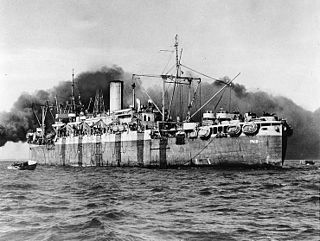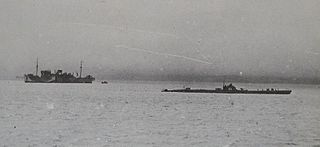Related Research Articles

A PT boat was a motor torpedo boat used by the United States Navy in World War II. It was small, fast, and inexpensive to build, valued for its maneuverability and speed but hampered at the beginning of the war by ineffective torpedoes, limited armament, and comparatively fragile construction that limited some of the variants to coastal waters. In the USN they were organized in Motor Torpedo Boat Squadrons (MTBRONs).

The United States Asiatic Fleet was a fleet of the United States Navy during much of the first half of the 20th century. Before World War II, the fleet patrolled the Philippine Islands. Much of the fleet was destroyed by the Japanese by February 1942, after which it was dissolved, and the remnants incorporated into the naval component of the South West Pacific Area command, which eventually became the Seventh Fleet.
They Were Expendable is a 1945 American war film directed by John Ford, starring Robert Montgomery and John Wayne, and featuring Donna Reed. The film is based on the 1942 book by William Lindsay White, relating the story of the exploits of Motor Torpedo Boat Squadron Three, a PT boat unit defending the Philippines against Japanese invasion during the Battle of the Philippines (1941–42) in World War II.
Motor Torpedo Boat Squadron Three was a United States Navy squadron based at Cavite, Philippines, from September 1941 to mid-April 1942. It was commanded by Lieutenant John D. Bulkeley and made up of six motor torpedo boats: PT-31, PT-32, PT-33, PT-34, PT-35, and PT-41, the last as the squadron flagship. The other six boats of the squadron remained at Pearl Harbor, Hawaii, and were there when war broke out, eventually being shipped to the Solomons.

Operation K was a Japanese naval operation in World War II, intended as reconnaissance of Pearl Harbor and disruption of repair and salvage operations following the surprise attack on 7 December 1941. It culminated on 4 March 1942, with an unsuccessful attack carried out by two Kawanishi H8K "Emily" flying boats. This was the longest distance ever undertaken by a two-plane bombing mission, and one of the longest bombing sorties ever planned without fighter escort.

WFNC is an AM radio station in Fayetteville, North Carolina broadcasting on frequency 640. The station has a conservative talk format and is under ownership of Cumulus Media. Its studios and transmitter are co-located in Fayetteville.

USS Whitman (DE-24) was an Evarts-class destroyer escort constructed for the United States Navy during World War II. It was promptly sent off into the Pacific Ocean to protect convoys and other ships from Japanese submarines and fighter aircraft. By the end of the war, when she returned to the United States, she had accumulated four battle stars.

WFAY is a radio station licensed to serve Fayetteville, North Carolina, United States. The station is owned by Jeffrey Andrulonis' Andrulonis Media. WFAY serves the Fayetteville area.
I-17 was a Japanese B1 type submarine of the Imperial Japanese Navy which saw service during World War II. This long-range submarine cruiser spent the early months of the war in the eastern Pacific and was the first Axis ship to shell the continental United States. She later supported the Imperial Japanese Army in fighting around the Solomon Islands and remained active in the southwest Pacific until she was sunk in August 1943.

SS President Roosevelt was an ocean liner in service in the 1920s and 1930s. Originally built as a Harris-class attack transport towards the end of World War I, she entered commercial service after her completion. Having been built as Peninsula State, she was soon renamed President Pierce and then President Roosevelt. Requisitioned for service as a troopship with the US Navy during World War II, she was renamed USS Joseph T. Dickman (APA-13) and served in the Atlantic and Pacific theaters, being scrapped postwar in 1948.

The seventh USS Niagara (CMc-2/PG-52/AGP-1) was an auxiliary ship of the United States Navy during World War II.
Huckins Yacht Corporation is one of the oldest boat builders in the United States. The company is located on the Ortega River in Jacksonville, Florida, and is run by its third-generation owners, Cindy and Buddy Purcell. Huckins manufactures custom yachts ranging from 40 to 90 feet that combine classic design and traditional workmanship with modern technology and amenities. It has built a total of 457 yachts during its 80 years of operation, crafting vessels one at a time.

PT-20 was the first PT-20-class motor torpedo boat of the United States Navy that served during World War II.

PT-30 was a PT-20-class motor torpedo boat of the United States Navy American that served during World War II.

PT-29 was a PT-20-class motor torpedo boat of the United States Navy American that served during World War II.

PT-42 was a PT-20-class motor torpedo boat of the United States Navy that served during World War II.

Q-111 Luzon was a motor torpedo boat of the United States Army during World War II as part of the Offshore Patrol based at Manila.
Q-112 Abra was a motor torpedo boat of the United States Army during World War II as part of the Offshore Patrol based at Manila.

I-71, later I-171, was a Kaidai-class cruiser submarine of the KD6 sub-class built for the Imperial Japanese Navy during the 1930s. She served in World War II, and took part in operations supporting the attack on Pearl Harbor, the Battle of Midway, and the Aleutian Islands campaign. She was sunk in February 1944.
I-123, originally named Submarine No. 50 then renamed I-23 from before her construction began until June 1938, was an I-121-class submarine of the Imperial Japanese Navy that served during the Second Sino-Japanese War and World War II. During the latter conflict, she conducted operations in support of the Japanese invasion of the Philippines, the Battle of Midway, the Guadalcanal campaign, and the Battle of the Eastern Solomons. She was sunk in 1942.
References
- 1 2 "20 Years of Big Bands in the Sandhills" by Michael Futch, The Fayetteville Observer, March 19, 2000
- ↑ "Obituary: G. Emerson Cole, 93, former Darien resident, WWII veteran, broadcaster". The Darien Times. 2012-04-03. Retrieved 2012-05-09.[ permanent dead link ]
- ↑ PT Boat Squadron 10
- ↑ PT-109 and PT-171
- ↑ Sketches and photos
- ↑ "Big Band Broadcast Takes Listeners Back" by Michael Futch, The Fayetteville Observer, January 2, 1990